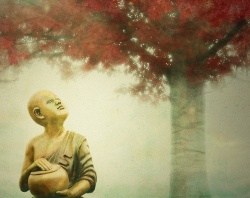Difference between revisions of "Theravada by Arnie Kozak, Ph.D."
| Line 5: | Line 5: | ||
[[Theravada Buddhism]] in {{Wiki|America}} | [[Theravada Buddhism]] in {{Wiki|America}} | ||
| − | The [[Theravada]] [[forms]] that have made their way to {{Wiki|America}}, especially, are more “[[Buddha]]” than “[[Buddhism]].” That is, they preserve the [[essential]] practices the [[Buddha]] developed and [[taught]] and most closely resemble his [[path]] to [[awakening]]. Notably, [[meditation]] is central to the [[Theravada]] [[traditions]] [[taught]] in {{Wiki|America}}, where [[interested]] parties can learn [[meditation]] through a [[traditional]] ten-day [[silent]] [[meditation retreat]]. Here you can engage in the core [[Buddhist practice]] of [[vipassana]] without having to engage with any [[rites]] or [[rituals]] or take any [[monastic]] [[vows]]. It's more of a bare {{Wiki|bones}} practice of [[Buddha]] and can be found in the teachings of [[S. N. Goenka]] from [[Burma]] who founded the [[Vipassana]] [[Meditation]] {{Wiki|Society}}, which has centers in the U.S. and all around the [[world]]. There are also teachings founded on the [[Thai Forest tradition]] with its main practice center, the [[Insight Meditation]] {{Wiki|Society}} in Barre, {{Wiki|Massachusetts}}, its sister nonresidential center Cam-bridge [[Insight Meditation]] Center, and the [[Spirit]] Rock Center in {{Wiki|California}}. | + | The [[Theravada]] [[forms]] that have made their way to {{Wiki|America}}, especially, are more “[[Buddha]]” than “[[Buddhism]].” That is, they preserve the [[essential]] practices the [[Buddha]] developed and [[taught]] and most closely resemble his [[path]] to [[awakening]]. Notably, [[meditation]] is central to the [[Theravada]] [[traditions]] [[taught]] in {{Wiki|America}}, where [[interested]] parties can learn [[meditation]] through a [[traditional]] ten-day [[silent]] [[meditation retreat]]. Here you can engage in the core [[Buddhist practice]] of [[vipassana]] without having to engage with any [[rites]] or [[rituals]] or take any [[monastic]] [[vows]]. It's more of a bare {{Wiki|bones}} practice of [[Buddha]] and can be found in the teachings of [[S. N. Goenka]] from [[Burma]] who founded the [[Vipassana]] [[Meditation]] {{Wiki|Society}}, which has centers in the [[U.S.]] and all around the [[world]]. There are also teachings founded on the [[Thai Forest tradition]] with its main practice center, the [[Insight Meditation]] {{Wiki|Society}} in Barre, {{Wiki|Massachusetts}}, its sister nonresidential center Cam-bridge [[Insight Meditation]] Center, and the [[Spirit]] Rock Center in {{Wiki|California}}. |
{{R}} | {{R}} | ||
[http://www.netplaces.com/buddhism/the-three-vehicles/theravada.htm www.netplaces.com] | [http://www.netplaces.com/buddhism/the-three-vehicles/theravada.htm www.netplaces.com] | ||
Latest revision as of 09:39, 24 February 2015
Theravada Buddhism can be traced all the way back to the First Council, shortly after Buddha's death. Theravada Buddhists claim that they have adhered to the Buddha's original teachings and are, therefore, the purist form of Buddhism. They established the Pali Canon, the teachings that were passed down orally for 400 years. The Pali language is still used as the primary language for the texts of Theravada Buddhists millennia later.
The Theravada (“Doctrine of Elders”) is the sole surviving school of Buddhism from the early days of Buddhism. It traces it roots back to the Buddha himself and his closest disciples. It is also known as southern Buddhism because this is where it has flourished over the centuries: Sri Lanka, Thailand, Burma, Cambodia, and Laos. Theravada keeps its ties close to the life of the Buddha and the Pali Canon (unlike Mahayana, which has introduced new texts and concepts). Theravada Buddhism in America
The Theravada forms that have made their way to America, especially, are more “Buddha” than “Buddhism.” That is, they preserve the essential practices the Buddha developed and taught and most closely resemble his path to awakening. Notably, meditation is central to the Theravada traditions taught in America, where interested parties can learn meditation through a traditional ten-day silent meditation retreat. Here you can engage in the core Buddhist practice of vipassana without having to engage with any rites or rituals or take any monastic vows. It's more of a bare bones practice of Buddha and can be found in the teachings of S. N. Goenka from Burma who founded the Vipassana Meditation Society, which has centers in the U.S. and all around the world. There are also teachings founded on the Thai Forest tradition with its main practice center, the Insight Meditation Society in Barre, Massachusetts, its sister nonresidential center Cam-bridge Insight Meditation Center, and the Spirit Rock Center in California.
